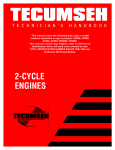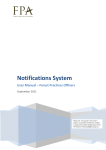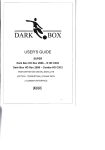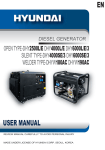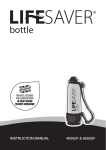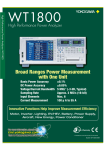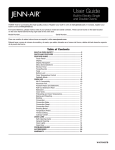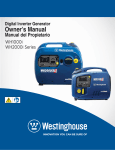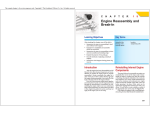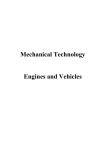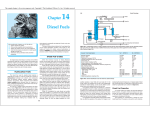Download Chapter 13 - Goodheart
Transcript
This sample chapter is for review purposes only. Copyright © The Goodheart-Willcox Co., Inc. All rights reserved. C H A P T E R 1 3 Preventive Maintenance and Troubleshooting Learning Objectives Key Terms After studying this chapter, you will be able to: compression gauge compression test coolant hydrometer differential pressure test digital tachometer filler plug hot spots loaded oil • Perform preventive maintenance on various engine systems, including the crankcase breather, air cleaner, and muffler. • Keep engines clean. • Change the oil in a four-cycle engine. • Prepare an engine for storage. • Describe systematic troubleshooting. • Use manufacturer’s service manuals to determine engine specifications and explain why this information is necessary when servicing a small engine. Preventive Maintenance S E C T I O N 4 Engine Service Chapter 13. Preventive Maintenance and Troubleshooting Chapter 14. Fuel System Service Chapter 15. Ignition and Electrical System Service Chapter 16. Engine Disassembly and Inspection Chapter 17. Cylinder, Crankshaft, and Piston Service Chapter 18. Camshaft and Valve Train Service Chapter 19. Engine Reassembly and Break-In Certain maintenance tasks must be performed regularly to keep an engine working properly. These tasks come under the heading of preventive maintenance, because they help prevent premature engine wear and other engine problems. Engine Cleaning Cleaning a small air-cooled engine periodically can help prevent overheating. For proper cooling action, air must pass across the extended metal surfaces (cooling fins) of the cylinder block and cylinder head. If the cooling fins are insulated by dirt, leaves, and/or grass clippings, engine parts will retain most of the combustion heat. Parts will expand, probably distort, and possibly seize. Therefore, all finned surfaces should be cleaned regularly. optical tachometer owner’s manual preventive maintenance reverse flushing service manual systematic troubleshooting thread chaser Methods for cleaning small air-cooled engines vary. Begin by removing any shrouds or engine covers obstructing the cooling fins. You can then blow debris from the fins with compressed air and use a cleaning solvent to remove any remaining dirt and oil. See Figure 13-1. Alternately, you can scrape the dirty areas with a piece of wood and wipe them with a clean cloth. Various multipurpose spray cleaners are suitable for use on small engines. Warning When using compressed air, be extremely careful where you direct the blast of air. Wear safety goggles. Never direct the air blast toward skin or clothing. In addition to cleaning cooling fins, be sure to clean the engine crankcase area. This area also transfers a great deal of engine heat to the surrounding air. A coating of dirt or oil will insulate the crankcase and may contribute to engine overheating. 243 This sample chapter is for review purposes only. Copyright © The Goodheart-Willcox Co., Inc. All rights reserved. 244 Section 4 Engine Service Figure 13-1. This chain saw engine is being cleaned with compressed air. Figure 13-2. Checking the oil is an important part of preventive maintenance. 245 Chapter 13 Preventive Maintenance and Troubleshooting The small engine manufacturer will recommend oil changes at intervals based on hours of running time. A new engine should have the first oil drained after only a few hours of operation to remove any metallic particles from the crankcase. After that, the time specified may vary from 10–50 hours. Engine oil does not wear out. It always remains slippery. However, oil used for many hours of engine operation becomes contaminated with dirt particles, soot, sludge, varnish-forming materials, metal particles, water, corrosive acids, and gasoline. These contaminants eventually render the oil useless. The harm they cause outweighs the lubricating quality of the oil. The time interval for oil changes is selected so that the oil never reaches a loaded level of contamination. Loaded oil cannot absorb any more contaminants and still be an effective lubricant. When oil reaches a loaded condition, varnish deposits begin to form on the piston and rings, and sludge collects in the crankcase. Note Some S ome engines engin ines do do nott have h e an oilil drain d i plug. l Oil mustt be b e drained drrain ned through throug gh the filler lle er hole on these engines. Clean the dirt from the drain plug area and then remove the plug with a proper wrench, Figure 13-5. Allow the oil to drain for approximately five minutes to remove as much contaminated oil as possible. See Figure 13-6. If the drain hole is located on the side or top of the engine, tilt the engine toward the drain hole if possible. When draining is complete, replace the drain plug. Checking Oil Level and Condition Crankcase oil in four-cycle engines should be checked periodically. Preferably, it should be checked each time fuel is added. The engine manufacturer provides a means of visually inspecting the level and condition of the oil. Use the type and viscosity grade of oil recommended by the manufacturer and maintain it at the proper operating level. To check the oil level in engines equipped with a dipstick, withdraw the dipstick and wipe it dry. Reinsert the dipstick as far as it will go. Withdraw it a second time and observe the oil level on the dipstick. See Figure 13-2. The markings on dipsticks may vary, but all will have a Low (Add) mark and a Full mark. Add oil if the level is at or below the Low mark. Do not run the engine with oil showing above the Full mark on the dipstick. If the crankcase oil level is high, drain some oil. Changing Oil Changing engine oil is not difficult. Begin by running the engine until it is thoroughly warmed up. Warm oil will drain more completely, and more contaminants will be removed if the oil is agitated. Turn off the engine and disconnect the spark plug. The oil drain plug is located at a low point on the crankcase, usually along the outside edge of the base. See Figure 13-4. Socket Figure 13-5. This technician is using a socket and ratchet to remove the drain plug. The plug should be turned counterclockwise for removal. Plug Figure 13-3. A screwdriver can be used to remove the type of oil filler plug shown here. Caution Overfi O verfifilli lling ing th the he crankcase crrankcase e with oil can foul plugs and ccause ause the engine eng gine e to o use e too much oil. Some small gasoline engines do not have dipsticks. Instead, they have a filler plug that threads into the filler hole to seal out dirt and seal in the oil. Figure 13-3 shows the proper method of loosening one type of filler plug. When the plug is removed, the oil level should be at the top of the filler hole or to a mark just inside the filler hole. If the engine oil level drops at an excessive rate (requires the addition of oil frequently), look for the cause. Refer to a troubleshooting chart for the particular engine at hand. Troubleshooting charts are covered later in this chapter. Typical causes of excess oil consumption are external leaks, worn oil seals around the crankshaft, worn valve guides, worn piston rings, or a hot running engine. The color of used oil is not always an accurate indication of its condition. Additives in the oil may change its color without decreasing its lubricating qualities. Drain plug Drain plug Figure 13-4. Figure 13-6. The oil drain plug is located at a low point in the crankcase to permit oil to drain completely. It may take several minutes for all the old oil to drain from the engine. This sample chapter is for review purposes only. Copyright © The Goodheart-Willcox Co., Inc. All rights reserved. 246 Section 4 Engine Service If the engine is equipped with a disposable oil filter, replace the filter each time the oil is changed. To prevent oil leaks, always coat the filter’s O-ring seal with a light coat of clean oil before installing the filter. See Figure 13-7. Before putting fresh oil in the engine, clean the filler opening, funnel, and the top of the oil container. Be sure to use the type, viscosity grade, and quantity of oil recommended by the manufacturer. Pour the oil in the engine’s crankcase and then check the level. See Figure 13-8. If the oil level is correct, replace the filler cap and reconnect the spark plug lead to the spark plug. Gasket Start the engine and allow it to run for a few minutes. Then stop the engine and recheck the oil level. Add oil as necessary. Finally, inspect the drain plug and oil filter for oil leaks. Lubricating Cables and Linkage Oil filter Clean the area around the filler opening, as well as the funnel, before adding oil. Spark plug If any oil is left in the oil container, cap the container tightly to prevent condensation or contamination. Many M anyy m manufacturers anu ufa acturrers recom recommend mmend silicone-based llubricants ubriccan nts fo or use e on cables and linkages. Unlike for petroleum-based p etro oleu um-b based products, these lubricants will not attract they applied. a ttra act dirt dirt after after th hey are ap pplied. Figure 13-8. Housing After After cchanging ha angin ng the the oil, wash wash oily rags or dispose of th hem properly. properlyy. Storing Storring them th hem may cause spontaneous them ccombustion. ombustio on. Spontaneous Spo onta aneo ous combustion occurs when ccombustible ombustib ble e material matterial self-ignites. Note A typical disposable oil filter. To prevent leaks, apply a light film of oil around the O-ring seal before installation. Cable Caution Engine cables and linkage should be lubricated periodically to ensure smooth operation and reduce the chances of binding and premature wear. Linkage (throttle linkage, governor linkage, etc.) can generally be lubricated by spraying it with an appropriate lubricant. Figure 13-7. 247 Chapter 13 Preventive Maintenance and Troubleshooting To lubricate cables (throttle cable, engine bale, etc.), place a few drops of the recommended lubricant between the cable and its housing at the highest end of the cable. Allow the lubricant to run down between the cable and housing. Lubricant should flow out of the low end of the cable. If it does not, add a few more drops of lubricant and allow it to run down the cable. Continue this process until clean lubricant flows from the bottom end of the cable. If desired, spray lubricant can be used to lubricate the cable. Simply spray the lube between the cable and the housing, and watch for it to exit at the low end of the cable. See Figure 13-9. Some manufacturers produce a tool that provides a leak-proof connection between the tube from a can of spray lubricant and the cable. When this tool is used, the lubricant is forced under pressure through the cable, making lubricating cables fast and easy. This type of tool is especially helpful when lubricating cables that run horizontally rather than vertically. Spray lubricant Boot Figure 13-9. Figure 13-10. Lubricant can be sprayed between the cable and the housing. When removing a spark plug wire from the plug, pull on the boot only. Do not pull on the wire itself. Wire-type feeler gauge Spark Plug Service The spark plug should periodically be removed for inspection and cleaned or replaced. Begin by using compressed air to blow dirt away from the base of the spark plug. Remove the spark plug wire from the plug by pulling on the wire’s insulating boot only. Do not pull on the wire itself. See Figure 13-10. Install a deep spark plug socket on the plug and carefully turn the ratchet handle counterclockwise. Unscrew the spark plug and remove it from the cylinder head. Carefully examine the electrode end of the plug. The electrodes and ceramic insulator should be dry. An insulator or electrodes that are wet with fuel or oil may be a sign of serious engine problems. A dry insulator that has a beige or gray/tan color indicates that the engine is in good condition. Next, examine the electrodes for any erosion, burning, or carbon fouling. Refer to Spark Plug Condition chart in the Appendix of this text. If the spark plug insulator and electrodes appear to be good (no evidence of fouling or wear), the plug can be reinstalled. If not, install a new plug of the correct type. Refer to the manufacturer’s technical service manuals for the proper replacement spark plug. Check the electrode gap with a wire-type feeler gauge, Figure 13-11. The engine service manual Figure 13-11. A wire-type feeler gauge is being used to check spark plug gap. will specify the proper gap setting. If the gap is too large, carefully bend the outer electrode toward the center electrode until the gap is correct. Use the gap setting tool. Before installing the spark plug, clean the external ceramic insulator by wiping it with a clean cloth. Condensation can cause flashover (sparking externally) and erratic running if the insulator has a coating of dirt on it. If the metal base is rusty, This sample chapter is for review purposes only. Copyright © The Goodheart-Willcox Co., Inc. All rights reserved. 248 clean it on a wire wheel or with a wire brush. If the threads are dirty, they should be wiped clean or wire brushed before inserting the plug back into the spark plug hole. The gasket should be in good condition or replaced with a new one. Insert the spark plug in the spark plug hole and turn it clockwise by hand until it stops. Be careful not to cross thread the spark plug in the hole. If the plug will not turn, do not force it. Remove it and examine the threads in the hole. If they are damaged, a thread chaser (special thread tapping tool) may be needed to clean and correct the threads. If the spark plug turns smoothly by hand until it seats, tighten the plug with a torque wrench to 13–15 lb ft. Do not overtighten. Examine the spark plug wire for deterioration before reinstalling it on the spark plug. Heat and dirt can make the insulation brittle and insulation cracking can occur. Cracked wire insulation can allow arcing to metallic parts of the engine and cause hard starting and erratic running. Oilor fuel-soaked wires will leak current and cause weak firing of the plug. The insulating boot should be dry and in good condition. Section 4 Engine Service Air cleaner receptacle A Cloth B Air cleaner cover C Figure 13-12. The cover on this air cleaner housing is held in place by a screw. Oil-wetted air cleaner D Figure13-14. The sequence for servicing a foam-type filter element is shown. A—Wash the foam element thoroughly in liquid detergent and water. B—Wrap the foam in cloth and squeeze it dry. C—Saturate the foam with clean oil. D—Squeeze out the excess oil. Cover Filter element Figure 13-15. The pleated paper should face the outside of the air cleaner receptacle (away from the engine). Pleated paper filter Caution Never N ever use use compressed com mpresssed d air i to t clean l the th paper fifilter filt lter b ecause the e air air ccan an n dam mage the filter element. The because damage damaged lter may d amaged fifilter may y not prevent prevent fine dirt from entering the engine. th he e ngin ne. Air Cleaner Service The air cleaner should be cleaned before each season of operation and at regular intervals thereafter. Under severe dust conditions, air filters should be cleaned more often. A plugged air filter can cause hard starting, loss of power, and spark plug fouling. Three types of air cleaners widely used in small gasoline engines are the oil-wetted (plastic foam element) type, the dry type (pleated paper element), and the dual-element type. Each has a different method of cleaning and servicing. Begin by removing the screw, wing nut, or other fastening device to uncover the air cleaner element. See Figure 13-12. When servicing an oil-wetted filter element, the element can be pulled from the receptacle after the cover is removed. See Figure 13-13. Be careful not to drop any dirt into the carburetor throat during this procedure. To clean the element, wash it in liquid detergent and water. Then rinse the element in clear water. After washing the element, wrap it in dry cloth and squeeze it dry. Absorbent toweling works well for this procedure. 249 Chapter 13 Preventive Maintenance and Troubleshooting Figure 13-13. After the cover is removed, the element can be pulled from the receptacle. The plastic foam should be saturated with clean engine oil. After saturating the element, squeeze excess oil out of the foam. See Figure 13-14. Finally, reassemble the air filter unit. Follow any special instructions found in the owner’s manual for the specific engine and filter. Most dry-type air filter elements (pleated paper) are designed to be thrown away when they become dirty. Nevertheless, you can clean a pleated paper filter element by tapping it on a flat surface to dislodge light accumulations of dirt. However, if the element will not tap clean, it must be replaced. When installing a pleated paper-type air filter element, the pleated paper should face the external side of the air cleaner receptacle. See Figure 13-15. Engines designed to be used in dusty conditions may have dual-element air cleaners. Dual-element air cleaners use a plastic foam filter pre-cleaner that is mounted over a pleated paper filter element. See Figure 13-16. When servicing this type of filter, the pre-cleaner can be washed in detergent and water and squeezed dry, Figure 13-17. Some precleaners must be oiled after they are cleaned. The paper filter element should be cleaned by shaking or replaced. Every engine to be serviced or repaired should have its air cleaner examined. If the air cleaner element or cartridge is damaged or shows signs of restriction, replace it. Worn or damaged mounting gaskets and air cleaner gaskets should be replaced to prevent dirt and dust from entering the engine through an improper seal around the filter. Pre-cleaner Figure 13-16. In a dual-element air cleaner, the pre-cleaner must be removed before the pleated paper filter can be serviced. Crankcase Breather Service If the small gasoline engine has a crankcase breather, the breather assembly should be removed and cleaned periodically. The breather is located over the valve stem chamber. It is held in place with two or more screws. To inspect the breather, remove the screws and the breather assembly. The breather contains a reed This sample chapter is for review purposes only. Copyright © The Goodheart-Willcox Co., Inc. All rights reserved. 250 Section 4 Engine Service This is the task of the exhaust system, which, in small gasoline engines, mainly consists of exhaust port(s) and a small muffler. A muffler is designed to reduce noise and allow exhaust gases to escape. When it becomes clogged with carbon soot, gases cannot get out of the combustion chamber quickly enough to allow fresh air and fuel to enter. This causes a loss in engine power, along with a tendency to overheat. If clogging is suspected with a sealed muffler, install a new muffler and check for improved engine efficiency. See Figure 13-19. If a muffler is designed to be taken apart, it can be disassembled and cleaned in a solvent to remove soot and other debris. Figure 13-17. The foam pre-cleaner can be washed in detergent and water and squeezed dry. Locking tab valve similar to the one shown in Figure 13-18. The valve allows outward airflow only. Inspect the valve to make sure it is not damaged or distorted. If it is, the breather assembly must be replaced. If applicable, see that the drain hole in the body of the assembly is open. This hole permits accumulated oil to return to engine. After all components have been inspected, replace damaged gaskets, reinstall the assembly on the engine, and tighten the screws. Muffler Service A An engine takes in large quantities of air mixed with fuel, and then burns the mixture. Unless the engine readily rids itself of the by-products of combustion, its efficiency will be greatly reduced. B Valve Drain hole Figure 13-18. Crankcase breather elements need periodic inspection. The function of the reed valve is to allow air to leave the crankcase, but prevent it from entering. Figure 13-19. Locking tabs are often used to prevent muffler fasteners from loosening. A—Before attempting to remove the fasteners, use a screwdriver to bend the tabs out of the way. B—Once tabs are bent down, a wrench can be used to remove the fasteners securing the muffler to the engine. 251 Chapter 13 Preventive Maintenance and Troubleshooting Battery Service The battery in a small engine–powered implement may be either a maintenance-free battery or a conventional lead-acid battery. Check the manufacturer’s service information to determine which type is being used. The maintenance-free battery should not be replaced with a conventional lead-acid battery. The electrical system is designed exclusively for a maintenance-free battery and the electrical system will not work properly with a conventional leadacid battery. Conventional lead-acid batteries need occasional additions of distilled water to keep the electrolyte level above the plates. Fill to the level shown on the case of the battery. Use a bulb syringe to add water and do not overfill. Maintenance-free batteries do not need to have fluid added and should not have the sealed caps removed. Removing, servicing, charging, or installing a battery must be done carefully to avoid spilling any electrolyte. Batteries produce hydrogen gas, which is very explosive. Keep batteries away from sparks, flame, etc. Charging and using a battery should be done in a well-ventilated space. Batteries electrolyte contains sulfuric acid, which can cause serious burns to the skin, eyes, or clothing if contact is made. Always wear eye protection when working with batteries. Batteries are secured in a battery box, tray, or similar device and securely fastened to the implement. The battery is held in position to resist being thrown about during operation. A loose battery would quickly result in a cracked case. This could cause serious damage to the implement and possible injury to the user. When servicing the battery, make sure the battery hold-down is tight and in good condition. Corrosion at the battery terminals and cable connectors is not uncommon. See Figure 13-20. The corrosion should be cleaned from the terminals. To clean the terminals, proceed as follows: 1. Remove the battery cable from the terminal. 2. Use a solution of baking soda and water to wash the cable connectors and battery terminals. (One teaspoon of baking soda to one cup of water). 3. Use a stiff brush to remove the corrosion from the cable connectors and battery terminals, Figure 13-21. Corroded terminal Figure 13-20. This battery terminal and cable connection is extremely corroded. Figure 13-21. A parts brush, old toothbrush, or other stiff-bristle brush should be used to remove the corrosion from the cable connectors and battery terminals. 4. Rinse the battery and connectors with clear water and dry the battery case and terminals with absorbent cloths, Figure 13-22. 5. Coat the terminals with a waterproof dielectric grease to prevent further corrosion. 6. Reinstall the battery cables on the battery terminals. In negative-ground systems, the positive cable should be connected before the negative cable. Charge a battery only when it needs it. Normally, the alternator driven by the engine keeps the battery charged. If the battery is old and does not crank the engine, it should be tested and possibly replaced with a new one. A battery that This sample chapter is for review purposes only. Copyright © The Goodheart-Willcox Co., Inc. All rights reserved. 252 Figure 13-22. After cleaning, rinse the battery, terminals, and cable connectors with clear water. is low on fluid will not take a full charge. This battery will eventually overheat the plates and fail completely. Sulfated plates will cause battery failure also. Refer to the Batteries section in Chapter 15 of this text for detailed information on charging batteries. Pressurized Liquid Cooling System Service The pressurized liquid cooling systems used in small engines require maintenance similar to that employed in the automobile engine. Because the combination of water and metal sometimes produces harmful chemical reactions that attack the water jacket, antifreeze containing a chemical rust inhibitor should be added whenever a system is drained and refilled. If rust and scale are allowed to form and accumulate, the walls of the water jacket will become insulated. This will cause engine heat to be retained rather than removed. Scale settling to the bottom may plug water passages in the cylinder block and clog water tubes in the radiator. Without free circulation of water, the engine will run hot even when the thermostat is open. Local hot spots can occur in the engine when the passages in the block are obstructed. In severe cases, water may boil inside the block, and the steam will prevent water from contacting and cooling inner walls. Then, serious overheating and damage to parts of the engine are bound to occur. Section 4 Engine Service The cooling fi ns that surround the tubes of the radiator should be kept clean for efficient heat transfer. Compressed air or pressurized water will remove any accumulations that might prevent air from passing through the fi ns and across the tubes. To remove debris, direct the flow of air or water in the opposite direction of normal airflow. Engine blocks and radiators may be cleaned periodically by reverse flushing the system with pressurized water. Disconnect the hoses from the radiator and the block. Force clean water through the block or the radiator in the direction opposite that of normal circulation. This will push loose sediment out. Continue flushing until the water runs clear. Flushing should be done with the engine stopped and cool. To remove additional rust clinging to inner surfaces, use a commercial cooling system rust remover. Follow the manufacturer’s instructions. When adding coolant, mix water and antifreeze as specified by the manufacturer. In most cases, a mixture that contains 50% water and 50% antifreeze is recommended. Never use just water. The 50/50 mixture will prevent the coolant from freezing in cold weather. It will also increase the boiling point of the coolant. Always check the strength of the coolant before the cold season begins. Weak coolant can freeze, causing damage to the engine block and radiator. Coolant strength can be checked with a device known as a coolant hydrometer. See Figure 13-23. To use the hydrometer, simply place the pickup tube in the engine coolant and squeeze the bulb to draw coolant into the hydrometer. Most hydrometers contain small balls that float in the coolant. The number of balls that float indicates the strength of the coolant. Some hydrometers have a pointer that indicates coolant strength on a scale printed on the body of the tester. 253 Chapter 13 Preventive Maintenance and Troubleshooting Figure 13-23. Coolant strength can be checked with a hydrometer. Engines operated in saltwater are exposed to extremely corrosive conditions. Exposed engine parts require careful maintenance. Flush the cooling system with fresh water after each use. Rinse the engine with freshwater and wipe all lower unit parts with a clean, oily cloth. Ignition leads and spark plug insulators should also be wiped frequently to prevent an accumulation of salt residue. Begin by thoroughly cleaning the engine. Layers of dirt and debris tend to hold moisture, encouraging the formation of rust and corrosion. Add fuel stabilizer to the fuel remaining in the tank and fill the tank with fresh gasoline. See Figure 13-24. Fuel stabilizer will help prevent fuel breakdown and the formation of gum, varnish, and corrosion in the fuel system. Start the engine and let it run for a few minutes so stabilized fuel flows through all parts of the fuel system. If fuel stabilizer is not available, run the engine dry of fuel. Next, drain the oil from the crankcase. Do not refill it now. Place a tag on the engine that says No Oil. Rotate the engine so the piston is at bottom of the cylinder. Remove the spark plug and squirt about one tablespoon of clean motor oil through the spark plug hole with an oil can. Rotate the engine slowly several times to distribute the oil on the cylinder walls. Then replace the spark plug. With the spark plug wire disconnected, use the pull rope to rotate the engine slowly until compression resistance is felt. Then rotate the engine an additional one-quarter turn to close off its ports. This seals the cylinder and prevents moisture entry. If possible, make sure the throttle is in the off position and the choke is closed. Then store the engine in a dry, clean area. When removing the engine from storage, fill the crankcase with the recommended type and amount of fresh oil (four-stroke engine). Then remove the spark plug and use the pull rope or starter to spin the engine rapidly to remove excess oil from the cylinder. Clean or replace the spark plug. Then clean and oil the air filter or replace cartridge if necessary. Note Outboard O utb boarrd e engines ng gines s used in saltwater should be immediately rremoved emoved d from fro om the e water im mmediately after operation. engine IIff tthe he e en ngine e cannot cann not be removed, rem moved, tilt the gearcase out off the o e water waterr and rrinse inse it with h freshwater. (The gearcase must m ustt be e removed rem moved from the water water when not in use.) Maintaining Outboard Cooling Systems Outboard engine cooling systems can be clogged with dirt, sand, or other debris. Flushing the internal cooling system of an outboard engine is extremely important. Flushing is done by attaching a freshwater hose to the water scoop or by operating the engine in a barrel of freshwater for several minutes. Storing an Engine Several precautions should be taken when storing an air-cooled engine for an extended period, such as when storing an implement for the winter season. Proper storage procedures will help ensure long engine life and easy starting the following season. Figure 13-24. Fuel stabilizer will help prevent fuel system problems. This sample chapter is for review purposes only. Copyright © The Goodheart-Willcox Co., Inc. All rights reserved. 254 Section 4 Engine Service If necessary, fill the fuel tank. If you are servicing a two-stroke engine, make sure the proper fueloil mixture is added to the tank. See Chapter 11 for additional information on mixing oil and fuel. Start the engine and let it idle until warm. Adjust the idle speed if necessary. Increase the engine speed in the normal manner. Make a brief test run while listening to the engine and watching the condition of all parts. Always take a systematic approach when troubleshooting small engines. Systematic troubleshooting involves checking and/or testing one component after another component until the problem is located and corrected. There are two basic principles to keep in mind when trying to pinpoint small engine problems: • Check the easiest things first. • Verify the fundamental operating requirements. Storing Liquid-Cooled Engines Check the Easiest Things First In addition to the storage precautions covered previously, storing liquid-cooled engines for lengthy periods, particularly during winter, calls for special maintenance procedures. If the engine has a pressurized system, the coolant must be strong enough to protect against freezing at the lowest possible temperatures. If the engine will not be started at any time during storage, drain the cooling system completely. Then, tag the engine to indicate its drained condition. When storing outboard engines, remove all plugs from the gearcase and drive shaft housing. This allows accumulated water in the gearcase and cooling system to drain off. Failure to take this precaution when winterizing may result in a cracked cylinder block and/or gearcase, plus possible damage to water channels and tubes. Rock the engine from side to side to make certain all water has drained. Refill the gearcase with the type of lubricant specified by the engine manufacturer. Attend to all other lubrication recommendations made by the manufacturer for care of the engine being stored. Always start troubleshooting by checking for the simplest, most probable problems first. If an engine will not start, the problem could be something as simple as an empty fuel tank or a disconnected spark plug wire. Do not start working on the carburetor or ignition system until you have made a few basic checks to determine that a simple remedy will not cure the problem. Systematic Troubleshooting Most small engine service and repair jobs can be done without taking the entire engine apart. If the engine will not start, is hard to start, runs rough, or lacks power, troubleshooting may be necessary. Troubleshooting is simply a number of tests and steps you go through to find a problem. Sometimes the cause of an engine problem is easy to find. At other times, checking probable causes requires a certain amount of reasoning and the use of the process of elimination. Also, more than one fault can exist at the same time, making it harder to locate the trouble. Verify the Fundamental Operating Requirements In order to start and run properly, an engine must meet five fundamental operating requirements. These requirements include: • Proper carburetion—Clean, fresh fuel must be delivered in the correct proportion with combustion air. • Correct ignition system operation—A strong ignition spark must be precisely timed for best performance and efficiency. • Adequate lubrication—The proper amount of high-quality lubricating oil must reach critical engine components. • Sufficient cooling—An ample supply of cooling air must reach engine. • Proper compression—Compression should have 30–45 psi minimum for starting and 90 psi minimum for efficient operation and sufficient power. Keep these operating requirements in mind when troubleshooting small gas engines. Through the process of elimination, you can easily isolate problems. For example, if an engine will not start but will spin normally, you can eliminate lubrication system problems because the engine is not locked-up. By spinning the engine, you can also determine whether or not it has sufficient compression. If the engine will not start after it has cooled down, the cooling system 255 Chapter 13 Preventive Maintenance and Troubleshooting can be eliminated as a potential problem. In a matter of seconds, you have determined that your troubleshooting efforts should be concentrated in the areas of carburetion and ignition. The engine’s owner can also provide assistance with your troubleshooting efforts. Ask a few questions about the engine’s performance before it stopped. Relate the answers to the operating requirements. For example, if an engine runs for 30-45 minutes and then stalls, you should ask if it restarts immediately after it stops. If the answer is yes, the problem is probably an ignition component that is intermittently experiencing heat-related breakdown. If the engine must cool before it will restart, vapor lock or sticking valves are possible problems. If a metallic snap is evident in the engine during the cooling period, the valves are likely to be the problem. The time you spend to ask a few pertinent questions can save a lot of time in the long run by eliminating additional problem possibilities. Checking RPM When servicing small engines, it is often necessary to test or set maximum idle rpm or governor rpm. One way to do this is by using a device that converts engine vibration from power pulses to rpm. See Figure 13-25. To use this tool, place the base of the instrument against the running engine. Using the dial on the tool, move the thin wire in or out of the instrument until the wire vibrates into a fan pattern. Continue to move the wire in or out until the fan pattern is as wide as possible. When fan pattern is as wide as you can make it, read the engine speed from the scale on the face of the instrument. A digital tachometer can also be used to check engine rpm. See Figure 13-26. The lead from this particular tachometer is simply wrapped around the spark plug wire. The tachometer will display engine rpm when the engine is running. Another convenient and accurate method of measuring rpm is with a portable optical tachometer like the one in Figure 13-27. Before using this type of tachometer, a small piece of reflective tape is placed on a rotating part of the engine such as the crankshaft, flywheel, or pulley. The optical tachometer is aimed at the rotating part. The rpm is read on the digital display in the window. This tachometer can measure from 5–100,000 rpm at a distance up to three feet and at an angle of 45°. These tachometers are small enough to fit in a pocket and weigh only 6 ounces. This is a safe method of measuring engine rpm, because contact with a hot engine is not necessary and a safe distance from moving parts can be maintained. Digital tachometer RPM scale Lead to spark plug wire Vibrating wire Figure 13-25. Figure 13-26. You can measure the speed of an engine through the vibrations caused by power pulses of the piston. A digital tachometer can be used to check engine rpm. This sample chapter is for review purposes only. Copyright © The Goodheart-Willcox Co., Inc. All rights reserved. 256 Section 4 Engine Service Testing Differential Pressure Figure 13-27. Figure 13-28. This optical tachometer can measure rpm without contacting the engine by aiming it at a rotating part that has a reflective tape attached. (Monarch Instrument) A compression test can indicate the condition of various mechanical components of an engine. Testing Compression A cylinder compression test can be a first step toward determining the condition of the upper major mechanical parts of the engine. This test is especially valuable if an engine lacks power, runs poorly, and shows little or no improvement after fuel system and ignition adjustments. To perform a compression test: 1. Run the engine until it is warm. 2. Disconnect all drives to the engine. 3. Open the choke and throttle valves wide. 4. Remove the air cleaner. 5. Remove the spark plug and insert the compression gauge. See Figure 13-28. 6. Crank the engine as fast as possible and read the gauge. Repeat the test to ensure accuracy. Note Engines E ngin ness equipped eq quip pped d with compression com mpression release ccamshafts amssha afts ma may ay have to be cranked in reverse rotation obtain tto o ob btain n an n accurate accu urate reading. readiing. An engine producing a compression less than the minimum specified by the manufacturer usually has one or more of the following problems: • Leaking cylinder head gasket. • Warped cylinder head. • Worn piston rings. • Worn cylinder bore. • Damaged piston. • Burned or warped valves. • Improper valve clearance. • Broken or weak valve springs. To determine whether the valves or rings are at fault, pour a tablespoonful of SAE 30 oil into the spark plug hole. Crank the engine several times to spread the oil and repeat the compression test. The heavy oil will temporarily seal leakage at the rings. If the compression does not improve, the leakage is due to problems with the valves, cylinder head, or piston. This does not disprove a problem with the rings; the engine may have worn rings in addition to its other problems. On the other hand, if the compression is much higher than the original test, the leakage is due solely to defective piston rings. 257 Chapter 13 Preventive Maintenance and Troubleshooting A differential pressure test checks the condition of an engine by measuring leakage from the cylinder to other parts of the engine. This test device and procedure can identify a specific worn or damaged component in the engine that may or may not be directly related to the cylinder condition or rings. The device is designed so that specific leakages can be detected and isolated before disassembling parts of the engine. The differential pressure tester requires the application of air pressure to the cylinder being tested with the piston at top dead center on the compression stroke. A schematic diagram of the differential pressure tester is shown in Figure 13-29. As the regulated air pressure is applied to one side tester with the air shutoff valve closed, both gauges will read the same. However, when the air shutoff valve is opened and leakage through the cylinder increases, the cylinder pressure gauge will record a proportionally lower reading. The differential pressure test can be applied to single cylinder engines or multiple cylinder engines. Each cylinder is tested separately and in the same manner. Use the following procedure to test: 1. Run engine until it is warmed up to provide uniform lubrication to cylinder walls and rings. 2. Remove the spark plug wire(s) and spark plug(s). Regulated pressure gauge Air shutoff valve Cylinder pressure gauge To air compressor Metering orifice Piston at top dead center 3. Rotate the engine crankshaft until the piston of the cylinder being tested is at top dead center of the compression stroke. Both valves must be closed. 4. Install the holding fixture supplied with the tester to prevent the crankshaft from turning during the test. 5. Thread the adaptor into the spark plug hole. 6. Connect the adaptor on the rubber hose to the quick disconnect fitting on the tester. 7. Connect an air source of at least 90 psi to the tester adaptor. Warning Make sure all personnel and objects are clear of the engine shaft, belts, pulleys, or other devices connected to the engine shaft. 8. Slowly adjust the regulated pressure gauge on the left with the regulator knob to read 80 psi. 9. The right-hand gauge indicates the relative pressure of the cylinder being tested. Due to standard engine clearances and normal wear, no cylinder is expected to maintain a perfect 80 psi. Generally, a reading of 60 psi or above is acceptable. Note Itt is imp important porttan nt tha that at all cylinders cylin nders on multi-cylinder engines e ngin nes s have hav ve a somewhat consistent reading. Good should jjudgment udgm men nt sho ould be used as as to the allowable tolerance between b etw ween n cylinders. cyylin nderrs. Recheck Rechec ck a cylinder that has a that rreading eading tha at iss signifi sig gnificantlyy lower (15 psi or more) than second tthe he other othe er cylinder(s). cyylin nderr(s). If a se econd reading is still low, tthe he cylinder cylin nderr should be suspected susp pected of being defective. 10. By listening for the sound of escaping air, you can determine leakage points in the engine and the cause of the low pressure reading. A hissing at the carburetor intake indicates a leaking intake valve, a hissing in the exhaust suggests a leaking exhaust valve, and hissing from the crankcase breather indicates leaking piston rings. See Figure 13-30. Note Figure 13-29. This schematic diagram shows a differential pressure tester connected to an engine cylinder. (Eastern Technology Corp.) IIff tthe he e test tes st indicates in ndicate es a valve problem, first check valve clearance c learrancce to m make akke sure the e valve is not being held open o pen n due du ue to o in inadequate nade equate cle clearance. earance. This sample chapter is for review purposes only. Copyright © The Goodheart-Willcox Co., Inc. All rights reserved. 258 Section 4 Engine Service Air Escaping from: Indication: carburetor intake defective intake valve exhaust system defective exhaust valve crankcase breather defective piston rings Figure 13-30. The chart shows the location of air leaks and the indicated defects. Service Information Before starting any maintenance, troubleshooting, or service procedures, the appropriate service information should be consulted. Basic maintenance and service information can often be found in the owner’s manual provided with the implement or the engine itself. The owner’s manual typically includes information on maintenance schedules, fluid capacities, and part numbers for maintenance components (filters, spark plugs, etc.). It may also include very basic maintenance and troubleshooting procedures. For example, the owner’s manual may include instructions for changing an engine air filter or diagnosing a nostart condition. Note Many M anyy engine en ngin ne and d implement manufacturers make ccopies opie es of of their th heir owner’s ow wner’s manual man nual available online. These manuals m anu ualss can ca an often ofte en be accessed acce essed free of charge. A service manual contains more detailed information than the owner’s manual. Service manuals are often published for each engine type a manufacturer produces. For example, one manufacturer publishes a manual for all variations of the singlecylinder engines it produces, and another manual for all two-cylinder engines it makes. Some companies publish service manuals for engines from a variety of manufacturers. Service manuals can generally be purchased directly from engine manufacturers, as well as from aftermarket publishers. Often, you can purchase service manuals at shops that sell engines and engine parts. Service manuals generally include comprehensive service procedures, detailed drawings of various engine assemblies, and troubleshooting charts, as well as a variety of tolerances, clearances, and specifications needed to properly troubleshoot and service a specific engine. The service procedures found in most manuals list the steps to take in order to accomplish a task effectively. The detailed drawings of assemblies and systems are often exploded views that can help you disassemble and reassemble parts in the right order. Troubleshooting charts list the most common engine troubles along with possible causes and suggested remedies. See Figure 13-31. Engine specifications, tolerances, and clearances are also given in a service manual. See Figure 13-32. When tolerance specifications show two values, the actual dimension must be somewhere between the two values. In Figure 13-32, for example, the cylinder bore (diameter) must measure somewhere between 2.1260″ and 2.1265″. Engine Identification In addition to having the correct service information, it is important to identify the exact model engine you are servicing. This will allow you to locate the proper specifications for the engine. It will also help ensure that you order the correct repair parts. Most engines have a model number displayed on a sticker affixed to the engine housing or to the engine itself. On some engines, the model number is stamped into the engine block, the metal shroud, or some other engine component. The model number will provide you with specific information about the engine at hand. For example, it will generally provide you with information on crankshaft orientation (vertical or horizontal), starter type (recoil start or electric start), carburetor type, etc. In addition to the model number, some manufacturers use ID numbers, serial numbers, or other code numbers that convey additional information. See Figure 13-33. These numbers may identify unique features of the engine. For example, the engine used on a certain model of lawnmower may have a crankshaft with a special snout to accommodate the mower’s blade. The numbers may also provide information on the date of engine manufacture, the location of the assembly plant, the engine warranty, emissions control compliance, etc. Information on interpreting model numbers, as well as other engine identification numbers, can be found in an appropriate service manual. 259 Chapter 13 Preventive Maintenance and Troubleshooting Cause Engine Troubleshooting Chart Remedy Engine fails to start or starts with difficulty No fuel in tank. Shut-off valve closed. Obstructed fuel line. Tank cap vent obstructed. Water in fuel. Engine overchoked. Improper carburetor adjustment. Loose or defective magneto wiring. Faulty magneto. Spark plug fouled. Spark plug porcelain cracked. Poor compression. No spark at plug. Fill tank with clean, fresh fuel. Open valve. Clean fuel screen and line. If necessary, remove and clean carburetor. Open vent in fuel tank cap. Drain tank. Clean carburetor and fuel lines. Dry spark plug and points. Fill tank with clean, fresh fuel. Close fuel shut-off and pull starter until engine starts. Reopen fuel shut-off for normal fuel flow. Adjust carburetor. Check magneto wiring for shorts or grounds; repair if necessary. Check timing, point gap; if necessary, overhaul magneto. Clean and re-gap spark plug. Replace spark plug. Overhaul engine. Disconnect ignition cut-off wire at the engine. Crank engine. If spark at spark plug, ignition switch, or safety switch interlock switch is inoperative. If no spark, check magneto. Crankcase seals and/or gaskets leaking (two cycle only). Replace seals and/or gaskets. Exhaust ports plugged (two cycle only). Clean exhaust ports. Engine knocks Carbon in combustion chamber. Remove cylinder head and clean carbon from head and piston. Loose or worn connecting rod. Replace connecting rod. Loose flywheel. Check flywheel key and keyway; replace parts if necessary. Tighten flywheel nut to proper torque. Worn cylinder. Replace cylinder. Improper magneto timing. Time magneto. Engine misses under load Spark plug fouled. Clean and regap spark plug. Spark plug porcelain cracked. Replace spark plug. Improper spark plug gap. Pitted magneto breaker points. Magneto breaker arm sluggish. Faulty condenser. Improper carburetor adjustment. Improper valve clearance. Weak valve spring. Reed fouled or sluggish (two cycle only). Crankcase seals leak (two cycle only). Re-gap spark plug. Replace pitted breaker points. Clean and lubricate breaker point arm. Check condenser on a tester; replace if defective. Adjust carburetor. Adjust valve clearance to recommended specifications. Replace valve spring. Clean or replace reed. Replace worn crankcase seals. Figure 13-31. Typical troubleshooting chart for small gas engines. (Continued) This sample chapter is for review purposes only. Copyright © The Goodheart-Willcox Co., Inc. All rights reserved. 260 Section 4 Engine Service Engine Troubleshooting Chart Cause Remedy 261 Chapter 13 Preventive Maintenance and Troubleshooting Engine Troubleshooting Chart Cause Engine lacks power Remedy Engine uses excessive amount of oil (four cycle only) Choke partially closed. Open choke. Engine speed too fast. Using tachometer, adjust engine RPM to specifications. Improper carburetor adjustment. Adjust carburetor. Oil level too high. Magneto improperly timed. Time magneto. To check level, turn dipstick cap tightly into receptacle for accurate level reading. Drain excess oil as needed. Worn rings or piston. Replace rings or piston. Air cleaner fouled. Clean air cleaner. Lack of lubrication (four cycle only). Fill crankcase to the proper level. Valves leaking (four cycle only). Grind valves and set to recommended specifications. Reed fouled or sluggish (two cycle). Clean or replace reed. Improper amount of oil in fuel mixture (two cycle only). Drain tank; fill with correct mixture. Crankcase seals leak (two cycle only). Replace worn crankcase seals. Engine overheats Oil filler cap loose or gasket damaged causing spillage Replace ring gasket under cap and tighten cap securely. out of breather. Breather mechanism damaged or dirty causing leakage. Replace breather assembly. Drain hole in breather box clogged causing oil to spill out of breather. Clean hole with wire to allow oil to return to crankcase. Gaskets damaged or gasket surfaces nicked, causing oil to leak out. Clean and smooth gasket surfaces. Always use new gaskets. Valve guides worn excessively thus passing oil into combustion chamber. Ream valve guide oversize and install 1/32″ oversize valve. Engine improperly timed. Time engine. Carburetor improperly adjusted. Adjust carburetor. Cylinder wall worn or glazed, allowing oil to bypass rings into combustion chamber. Piston rings and grooves worn excessively. Bore, hone, or deglaze cylinder as necessary. Reinstall new rings, check land clearance, and correct as necessary. Airflow obstructed. Remove any obstructions from air passages in shrouds. Piston fit undersized. Measure and replace piston as necessary. Cooling fins clogged. Clean cooling fins. Piston oil control ring return holes clogged. Remove oil control ring and clean return holes. Excessive load on the engine. Check operation of associated equipment; reduce excessive load. Oil passages obstructed. Clean out all oil passages. Carbon in combustion chamber. Remove cylinder head and clean carbon from head and piston. Lack of lubrication (four cycle only). Fill crankcase to proper level. Improper amount of oil in fuel mixture (two cycle only). Drain tank; fill with correct mixture. Engine surges or runs unevenly Figure 13-31. Tolerances and Clearances for the J-321 Engine Cylinder bore Max. Min. 2.1265″ 2.1260″ Piston skirt diameter Max. Min. 2.1227″ 2.1220″ Fuel tank cap vent hole clogged. Open vent hole. Governor parts sticking or binding. Clean and, if necessary, repair governor parts. Carburetor throttle linkage or throttle shaft and/or butterfly binding or sticking. Clean, lubricate, or adjust linkage and deburr throttle shaft or butterfly. Piston ring width Max. Min. .0935″ .0925″ Intermittent spark or spark plug. Disconnect ignition cut-off wire at the engine. Crank engine. If spark, check ignition switch, safety switch, and interlock switch. If no spark, check magneto. Check wires for poor connections, cuts or breaks. Piston pin diameter Max. Min. .5001″ .4999″ Max. Min. .0045″ .0033″ Improper carburetor adjustment. Dirty carburetor. Adjust carburetor. Engine not securely mounted. Tighten loose mounting bolts. Bent crankshaft. Replace crankshaft. Associated equipment out of balance. Check associated equipment. Continued. Piston skirt to cylinder clearance .030″ Clean carburetor. Engine vibrates excessively Figure 13-31. Spark plug gap Figure 13-32. Typical tolerance and clearance chart. (Jacobsen Mfg. Co.) Figure 13-33. Identification numbers found on an engine provide valuable information. This sticker displays the engine’s build date and serial number. This sample chapter is for review purposes only. Copyright © The Goodheart-Willcox Co., Inc. All rights reserved. 262 Summary Preventive maintenance involves tasks that must be performed regularly to keep an engine working properly. Cleaning a small air-cooled engine periodically can help prevent overheating. For proper cooling action, air must pass across the metal surfaces of the cylinder block and cylinder head. If the cooling fins are insulated by dirt, leaves, and/or grass clippings, engine parts will retain most of the combustion heat. Parts will expand, probably distort, and possibly seize. Crankcase oil in four-cycle engines should be checked periodically. The small engine manufacturer will recommend oil changes at intervals based on hours of running time. The time specified may vary from 10–50 hours. Engine cables and linkage should be lubricated periodically to ensure smooth operation and reduce the chances of binding and premature wear. Many manufacturers recommend silicone-based lubricants for use on cables and linkages. Unlike petroleum-based products, these lubricants will not attract dirt after they are applied. The spark plug should periodically be removed for inspection and cleaned or replaced. Carefully examine the electrode end of the plug. An insulator or electrodes that are wet with fuel or oil may be a sign of serious engine problems. If the spark plug insulator and electrodes appear to be good, the plug can be reinstalled. Examine the spark plug wire for deterioration before reinstalling it on the spark plug. Heat and dirt can make the insulation brittle and insulation cracking can occur. The air cleaner should be cleaned before each season of operation and at regular intervals thereafter. A plugged air filter can cause hard starting, loss of power, and spark plug fouling. The three types of air cleaners widely used in small gasoline engines are the oil-wetted type, the dry type, and the dual-element type. Each has a different method of cleaning and servicing. If the small gasoline engine has a crankcase breather, the breather assembly should be removed and cleaned periodically. The breather is located over the valve stem chamber. A muffler is designed to reduce noise and allow exhaust gases to escape. When it becomes clogged, gases cannot get out of the combustion chamber quickly enough to allow fresh air and fuel to enter. Section 4 Engine Service This causes a loss in engine power, along with a tendency to overheat. The battery in a small engine–powered implement may be either a maintenance-free or a conventional lead-acid battery. Conventional lead-acid batteries need occasional additions of distilled water to keep the electrolyte level above the plates. Fill to the level shown on the case of the battery. Corrosion at the battery terminals and cable connectors is not uncommon. The corrosion should be cleaned from the terminals. The pressurized liquid cooling systems used in small engines require maintenance similar to that employed in the automobile engine. Because the combination of water and metal sometimes produces harmful chemical reactions that attack the water jacket, antifreeze containing a chemical rust inhibitor should be added whenever a system is drained and refilled. Outboard engine cooling systems can be clogged with dirt, sand, or other debris. Flushing the internal cooling system of an outboard engine is extremely important. Several precautions should be taken when storing an air-cooled engine. Proper storage procedures will help ensure long engine life and easy starting the following season. Storing liquidcooled engines for lengthy periods calls for special maintenance procedures. If the engine has a pressurized system, the coolant must be strong enough to protect against freezing at the lowest possible temperatures. If the engine will not start, is hard to start, runs rough, or lacks power, troubleshooting may be necessary. Troubleshooting is simply a number of tests and steps you go through to find a problem. In order to start and run properly, an engine must meet five fundamental operating requirements. These requirements include proper carburetion, correct ignition system operation, adequate lubrication, sufficient cooling, and proper compression. A cylinder compression test can be a first step toward determining the condition of the upper major mechanical parts of the engine. This test is especially valuable if an engine lacks power, runs poorly, and shows little or no improvement after fuel system and ignition adjustments. A differential pressure test checks the condition of an engine by measuring leakage from the cylinder to other parts of the engine. This test device and procedure can identify a specific worn or damaged component in the engine that may or may not be directly related to the cylinder condition or rings. 263 Chapter 13 Preventive Maintenance and Troubleshooting Before starting any maintenance, troubleshooting, or service procedures, the appropriate service information should be consulted. Basic maintenance and service information can often be found in the owner’s manual. A service manual contains more detailed information than the owner’s manual. In addition to having the correct service information, it is important to identify the exact model engine you are servicing. This will allow you to locate the proper specifications for the engine. It will also help ensure that you order the correct repair parts. Review Questions Answer the following questions on a separate sheet of paper. 1. True or False? Preventive maintenance helps protect against premature engine wear. 2. Keeping an engine clean can help prevent . 3. True or False? Never run an engine if the oil level is above full mark. 4. Although oil does not wear out, excess make the oil useless. . 5. When changing oil, the engine should be A. cold B. warm C. running D. None of the above. 6. Many manufacturers recommend using -based lubricants on cables and linkages. 7. True or False? Most manufacturers recommend replacing a carbon-fouled spark plug. 8. Name three problems caused by a plugged air filter. 9. Why should you refrain from using compressed air to clean a pleated paper air filter element? 10. What two problems can be caused by a clogged muffler? 11. True or False? All mufflers can be cleaned by soaking them in solvent. 12. When storing an engine for an extended period, should be added to the gasoline to prevent fuel breakdown and the buildup of gum, varnish, and corrosion. 13. To prevent the formation of rust and scale, should be antifreeze containing a rust used in the cooling system. 14. Outboard engines operated in saltwater are exposed to conditions. 15. When storing outboard engines, all plugs should be removed from the and housing. 16. Systematic troubleshooting involves looking for the possible problem first. 17. In order to run properly, an engine must have proper carburetion, correct ignition system operation, adequate lubrication, sufficient cooling, and . 18. True or False? A compression test can be used to determine the condition of the spark plug. 19. During a differential pressure test, air leakage heard at the crankcase breather is an . indication of defective 20. Manufacturer’s service manuals contain . A. service procedures B. troubleshooting charts C. tolerance and clearance specifications D. All of the above. Suggested Activities 1. Perform preventive maintenance procedures on several engines in your shop. Check the oil level and condition. If necessary, change the oil and the filter. Make sure the air filter element, crankcase breather (if applicable), and cooling fins are clean. If engine is equipped with a water cooling system, check engine block and radiator for signs of rust and corrosion. 2. Locate several malfunctioning engines. Try to determine the cause of the problems using the systematic troubleshooting method. Remember the five fundamental operating requirements. 3. Perform a differential pressure test on an engine and determine the condition of the rings and valves. 4. Review several manufacturers’ service manuals. Study trouble code charts and exploded-view assembly drawings. Check maintenance procedures for engines in your shop. This sample chapter is for review purposes only. Copyright © The Goodheart-Willcox Co., Inc. All rights reserved. 264 Section 4 Engine Service When equipment is being refueled or the fuel system is being serviced, care must be taken to minimize spillage. (glennebo/Shutterstock)













